
Oldham's leaf turtle is a species of turtle in the family Geoemydidae.
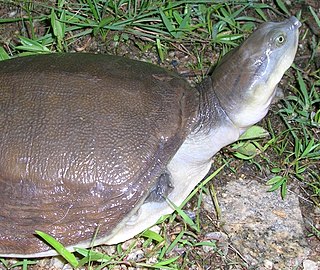
Lissemys is a genus of softshell turtles in the subfamily Cyclanorbinae of the family Trionychidae. The genus is indigenous to southern Asia.

Pelochelys is a genus of very large softshell turtles in the family Trionychidae. They are found from peninsular India northeast to southern China, and south to Southeast Asia and New Guinea.

The Mexican box turtle is a species of box turtle belonging to the family Emydidae. It is sometimes treated as a subspecies of Terrapene carolina.

The Nubian flapshell turtle or Nubian soft-shelled turtle is one of two species of softshell turtle in the genus Cyclanorbis of the Trionychidae family. It has historically been found in a wide range spanning Benin, Central African Republic, Chad, Ethiopia, Ghana, Nigeria, Sudan, and Togo. However, it has been very rarely recorded during the last 50 years and there is little hope that the species is extant in Ghana, Benin, Togo, Nigeria and Cameroon. In early 2019, a remnant population was found in the White Nile wetlands in South Sudan by Prof. Luca Luiselli and his team.

The Senegal flapshell turtle is a species of turtle in the subfamily Cyclanorbinae of the family Trionychidae. The species, which is one of two species of softshell turtles in the genus Cyclanorbis, is endemic to Africa.

Cycloderma is a genus of softshell turtles in the subfamily Cyclanorbinae of the family Trionychidae. The genus is endemic to Africa.
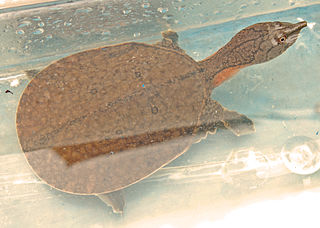
The Malayan softshell turtle is a species of softshell turtle in the family Trionychidae. It is monotypic in its genus.
The Namoi River snapping turtle, also commonly known as Bell's turtle, the Namoi River elseya, or Bell's saw-shelled turtle, is a species of turtle in the family Chelidae. The species is endemic to New South Wales, Australia.
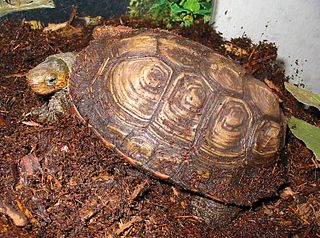
Rhinoclemmys is a genus of turtles in the family Geoemydidae, the only genus in the subfamily Rhinoclemmydinae. Member species of the genus are commonly known as the Neotropical wood turtles and are the only geoemydids known from the Americas. As such, they have adapted to a wide range of habitats, which is reflected in the species' common names.
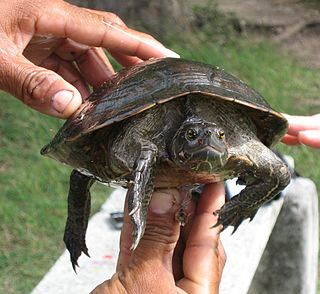
The Central Antillean slider, is a species of turtle in the family Emydidae. The species is found on three islands in the West Indies: Hispaniola, Great Inagua, and Puerto Rico.
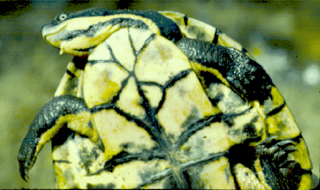
The Myuchelys is a genus of turtles, the Australian saw-shelled turtles, in the family Chelidae and subfamily Chelodininae. They inhabit the headwaters and tributaries of rivers within their range and this led to the name Myuchelys, which is formed from the Aboriginal word myuna meaning clear water and the Greek chelys meaning turtle. They have a short neck and the intergular scute completely separates the gular scutes. They have no alveolar ridge separating them from the snapping turtles of the genus Elseya.

Cyclanorbinae, also known commonly as the flapshell turtles, is a subfamily of softshell turtles in the family Trionychidae. The subfamily is native to Africa and Asia.

The Cuatro Ciénegas slider is a species of turtle belonging to the genus Trachemys of the family Emydidae.

The furrowed wood turtle is a species of turtle belonging to the genus Rhinoclemmys of the family Geoemydidae found in the Yucatán Peninsula and adjacent regions of Central America.

The Colombian wood turtle is one of nine species of turtle belonging to the genus Rhinoclemmys of the family Geoemydidae. It is found in Colombia, Ecuador, and Panama.

The painted wood turtle or spot-legged wood turtle is a species of turtle belonging to the genus Rhinoclemmys of the family Geoemydidae.
The Central African mud turtle is a species of turtle in the family Pelomedusidae. The species is endemic to Central Africa.
The Ivory Coast mud turtle is a species of turtle in the family Pelomedusidae. It is one of the most recently described turtle species. It is found in Sierra Leone, Liberia, Côte d'Ivoire, Ghana, Togo and Benin.
The African dwarf mud turtle is a species of turtle in the family Pelomedusidae. It is endemic to Africa : in Angola, the Democratic Republic of the Congo, Malawi, and Zambia. These mud turtles are the smallest of all African turtle species, “Nanus” which they are referred to are one of the 3 smallest turtle species in the world. The other two are Stink Pot Musk and Muhlenberg's Bog Turtles. All 3 species barely reach 4 inches as full grown adults. Like many of the world's chelonians, Pelusios castaneus has the potential to live a long life. Reports typically suggest more than 50 years in captivity for this species.
















